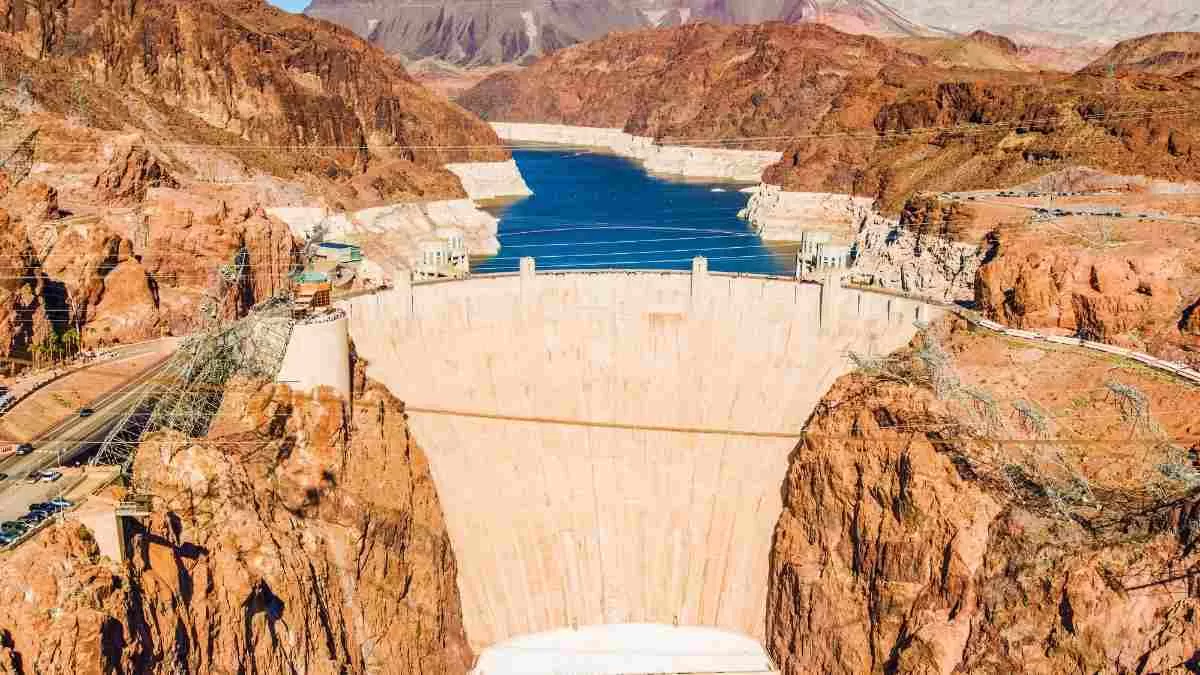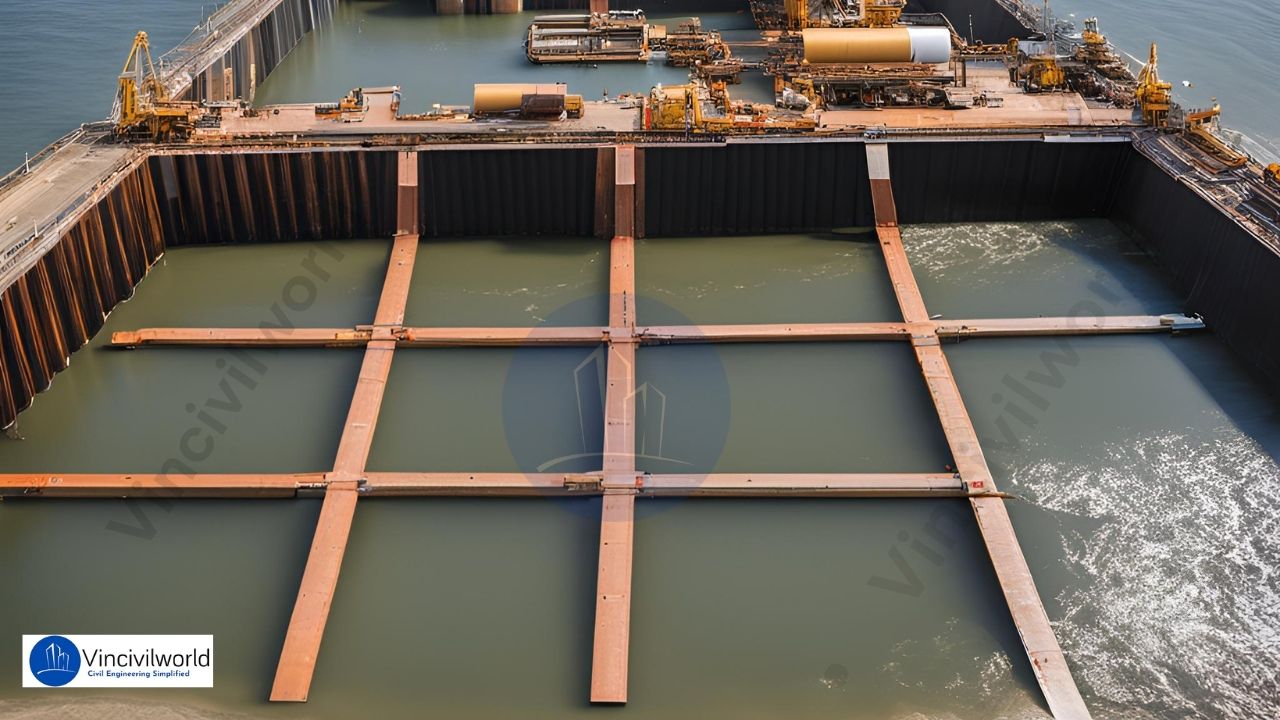Components of dams are crucial for ensuring their strength, safety, and functionality. Understanding the components of dams helps engineers and students grasp how these massive structures manage water flow and provide stability. The main components of a dam include the foundation, body or dam wall, spillway, and outlet works. Each part of a dam plays a specific role in controlling water and preventing failures. Knowing the different parts of a dam, such as the core, abutments, and drainage systems, is important for construction and maintenance. Engineers and planners require dams for a wide range of projects, including small irrigation and water supply schemes as well as larger hydropower and disaster management schemes. They construct small and large dams to provide reliable water for agriculture, support municipal supply, generate electricity, and manage floods efficiently.
Dams’ primary responsibility of managing water is managed by each component in a specific way. This article will explore dam structure components, their functions, and the types of dam components found in various designs, providing a clear overview for anyone interested in dam engineering or infrastructure.
Table of contents
What is a dam ?
A dam is a barrier constructed across a river or stream to hold back and control the flow of water. It creates a reservoir that stores water for various uses such as irrigation, drinking water, flood control, and hydroelectric power generation. The upstream side of a dam is the area where the water is collected. The water level is high on the upstream side. The components of dams work together to ensure the structure’s stability and effective water management. Understanding these components is key to appreciating how dams function and serve essential roles in water resource management and infrastructure development.
Advantages of Dams
The dams provide a range of environmental, economic and social benefits. One of the most important benefits of dams is water storage. People use the stored water for drinking, cleaning, bathing, gardening, irrigation, and industrial purposes.
Dams are constructed to meet the following functions
- Water storage: They are one of the major sources of water for domestic uses like cooking, cleaning, bathing, washing, drinking water, gardening, agricultural uses, industrial purposes, etc. The water is supplied through the canal or with the help of a pipe system from the dam.
- Irrigation – Irrigation authorities divert water from the dam through canals to fields with low water levels for irrigation purposes.
- Hydroelectric power – Engineers pass the water stored in the dam through turbines to generate hydroelectric power.
- Flood prevention – The water level of rivers, streams, etc is maintained by constructing a dam across it. This prevents the loss and damage from unexpected floods.
- Recreation – The water stored in the dam is used for fishing, boating, and other recreational activities.
- Debris control – The dam also provides the retention of hazardous material and protects the environment.
Components of Dams
The components of dams play an important role in maintaining the primary responsibility of water management. The parts of the dams are broadly classified as follows.
- Water-retaining structure
- Water-releasing structure
- Water conveying structure
Components of Dam – Youtube video
Water-retaining structure – Components of Dam
The dam’s walled structure resists water while allowing a controlled amount to flow downstream. Accordingly, we call the side where water collects the upstream side, and the side where water flows away the downstream side. Generally, the following component of dams makes up the dam’s water-retention section,
- Heel
- Toe
- Abutment
- Crest
- Cutoff
- Parapet wall
Heel of dams
We call the upstream or groundwater side of the dam the heel. (Ref fig.)
Toe – Main component of dams
The portion of the dams meeting with the groundwater or downstream side is called the Toe.(Ref fig)
Abutment of dam
Abutments support the lateral pressure. These are the sides of the valley. These are concrete or masonry structures.
Crest/Roadway of Dams
The section of the dams used as a roadway or walkway is the crest. It is the upper area of the dam.
Cut off
The cut-off is an impervious barrier constructed beneath the earthen dams. The main function is to reduce the loss of stored water in the reservoir by preventing seepage.
Parapet wall
The parapet wall is seen below the crest near the roadway. This assists in the dam investigation and safety barriers.
Water-releasing structure: Components of dams
Mainly, the water-releasing structure components of dams allow water to flow downstream. Engineers generally call these dam components the dam’s spillways. Generally, the spillway’s mechanism allows for controlled water volume. A spillway contains the following components.
- Galleries
- Spillways
- Diversion tunnel
- Sluiceway
- Freeboard
Galleries of dams
These are hollow openings passing through the dam as shown in fig. The main purpose of providing a drainage gallery is to collect seepage water from the foundation and body of the dam and drain it out. Foundation galleries receive seepage water and drain it away under gravity. We broadly divide the galleries into the following types.
- Grouting gallery
- Inspection Gallery
- Drainage gallery
- Valve gallery
- Transformer Gallery
Grouting Gallery
A grouting gallery is a horizontal passage near the dam base, used to inject grout into the foundation to seal cracks, reduce permeability, and control seepage. This helps strengthen the dam’s foundation and prevents water from weakening structural elements. It plays a critical role during dam construction and maintenance.
Inspection Gallery
Engineers and technicians examine the internal condition of the dam using an inspection gallery, a tunnel-like corridor built inside the structure. It ensures safe access for monitoring seepage, stress, and stability. Regular inspections help detect early warnings of structural issues, leaks, or deterioration inside the dam.
Drainage Gallery
A drainage gallery collects and channels seepage water from inside the dam and its foundation through gravity flow. Small weep holes or drains connect to this gallery, preventing water buildup and reducing hydrostatic pressure. The collected water is then discharged safely away from the structure to maintain dam stability.
Valve Gallery
A valve gallery houses control valves, gates, and operating equipment that regulate the flow of water through outlets or penstocks. Maintenance staff use it to operate and inspect valve systems safely. It plays a key role in water supply, irrigation release, or emergency overflow during high reservoir levels.
Sketch idea: Enclosed passage in the dam with labeled valves and pipelines connected to outlet conduits.
Transformer Gallery
Exclusive to hydroelectric dams, the transformer gallery contains transformers and power equipment for managing and distributing electricity generated by turbines. Proper ventilation and safety controls are essential in this gallery. It serves as the operational link between turbine rooms and external power transmission systems, ensuring efficient energy flow.
Spillway of dams
The role of the spillway is to convey excess water and prevent damage. The water passes from upstream to downstream. The spillway helps in the emergency discharge of water.
They are two varieties
- Controlled spillway
- Uncontrolled spillway
In a controlled spillway the flood flow is regulated by the gate.
Also Read : Spillway types and features – A comprehensive guide
Diversion tunnel of dams
The purpose of the diversion canal is to redirect the water. Diversion tunnels are constructed during the construction stage of dams.
Engineers construct a diversion tunnel to divert floodwater from mountainous regions to low-lying areas experiencing water shortages
Sluice way of dams
The role of the sluiceway is to remove the silt accumulated.
Freeboard of dams
The interval between the dam heads to the maximum water level on the upstream side.
Water conveying structure – Components of dams
Water-conveying structure mainly conduit and conveys the water from reservoirs through, around, or under an embankment dam
Conduit
These are closed pipe structures. Conduits act as a passage for the water supply. Bottom discharge conduits are pipes that cross the body of the dam from the upstream to the downstream sides enabling water flow.
Examples of some major dams
Bhakra Dam ( Gravity dam )
Engineers built the Bhakra Dam, an Indian gravity dam, across the river Sutlej in Himachal Pradesh. They completed the construction in 1963. The height of the dam is 226 meters. The length of the dam is 518 meters.
Gobind Sagar is a reservoir of this dam. The Bhakra Dam is composed of alternating layers of light red clays and sandstone.
This dam has four spillways. It helps in irrigation, hydroelectric power generation and recreation. The major source of irrigation water supply in Haryana, Punjab and Rajasthan is this dam.
Idukki dam ( Arch dam )
Idukki dam is an arch dam constructed across the Periyar river in Kerala. It is 554 feet high. One of the biggest arch dams in Asia. The dam provides hydroelectricity, irrigation and tourist destinations. It is built between Kuravan and Kurathi hills.
Nagarjuna Sagar Dam (Masonry Dam)
Engineers constructed the Nagarjuna Sagar Dam as a stone masonry dam and completed it in 1967. The dam is a symbol of modern architecture. The purpose of this project was to generate hydroelectricity. It has a 26-crest gate.
The Hirakud Dam (Earthern dam)
The Hirakud dam is located in Orissa state over the river Mahanadi near Sambalpur. The length of the dam is 4800 meters and 59 meters high. It is the oldest multipurpose dam completed in 1957.
The Hirakud Dam is the 4800-meter long and 59 meters high. The gross storage capacity of the dam is 1841 million cum.
KARIBA DAM (Double curvature arch dam)
Engineers constructed the Kariba Dam as a double-curvature arch dam over the Zambezi River in 1960.The crest length is 620m and 128m high. The dam provides an example of improving the quality of rocks.
Key Takeaways
- Primary Functions: Dams manage water for various uses, including storage, irrigation, hydroelectric power, flood prevention, recreation, and debris control.
- Components: The main components include water-retaining structures such as the heel, toe, abutment, crest, cutoff, and parapet wall. Water-releasing structures include galleries, spillways, diversion tunnels, sluice ways, and freeboard. Water-conveying structures are conduits.
- Types of Dams: Dams vary by construction and purpose. Examples include gravity dams, arch dams, masonry dams, earthen dams, and double curvature arch dams.
- Examples: Major dams include Bhakra Dam, Idukki Dam, Nagarjuna Sagar Dam, Hirakud Dam, and Kariba Dam.
- Environmental and Economic Benefits: Dams provide essential benefits like water supply, power generation, flood control, and recreational opportunities.
Conclusion
Dams are crucial infrastructure for effective water management and offer significant environmental, economic, and social benefits. We can appreciate the role of dams by understanding their various components and functions. They are important for water storage, irrigation, hydroelectric power, and flood prevention. Each component plays a vital part in the dam’s functionality. From the water-retaining to the water-releasing and conveying structures, they ensure efficiency. Examples like Bhakra Dam, Idukki Dam, and Kariba Dam demonstrate the diverse applications and benefits of these impressive engineering feats. Effective dam management is essential for sustainable development and environmental protection.








Can we build a dam that uses the tide? Something like when uptide occurs, we collect the water in the reservoir and when downtide occurs we release the water producing electricity